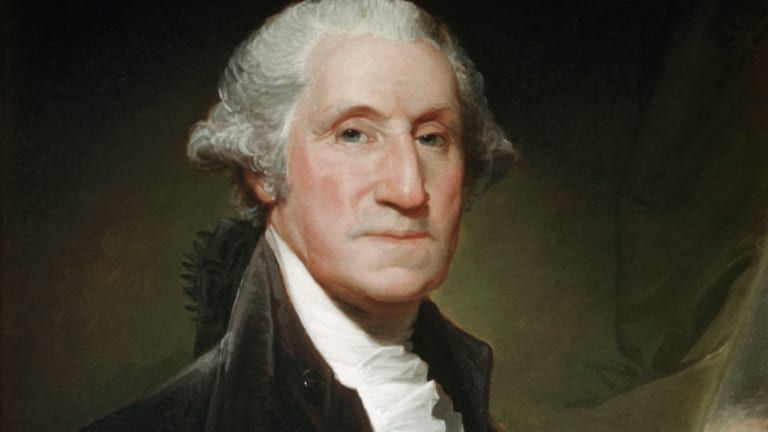Last updated on April 9th, 2024 at 03:37 am
The Red Scare of 1919-1920 is one of the most interesting periods of modern American history. It came about in the aftermath of World War One.
The Red Scare, which later became the First Red Scare after similar worries about communists broke out following World War Two, was characterized by extreme government overreach into American civil liberties. This was due to unfounded fears of German espionage and Bolshevik revolution.
Throughout the roughly two-year period, the US populous was grappling with intense fears of an impending communist revolution in America. It resulted in a series of bombings, riots, strikes, and thousands of illegal arrests.
But with so much history to cover, what exactly caused the Red Scare, and what were the major events that transpired?
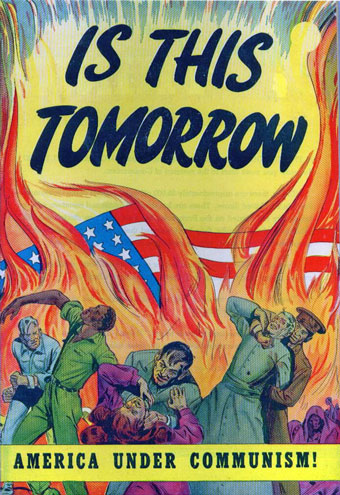
Origins of the Red Scare
Though the Red Scare officially started in 1919, the conditions were set for it to occur several years beforehand.
During the lead-up to the US entry into World War One, there had been a growing debate about organized labor and workers’ rights in the United States. Labor unions became increasingly popular partly.
This was due to a redress of wrongs during the Gilded Age which saw unbridled capitalism taking advantage of many US workers. Unions such as the International Workers of the World and others became powerhouses in American politics.
New political parties, such as the Socialist Party, also began to make major headway. For example, by the time the US entered the war, the Socialist Party had 30 members sitting in state houses and over 1000 members serving in various political offices nationwide.
Concurrently, the anarchist movement was also continuing to gain traction. Though always on the fringe of society, these groups rose to national prominence after the 1886 Haymarket bombings in Chicago.
Labor Unions
In the several decades that followed, US political leadership continued to make accusations of anarchist ties to organized labor unions. Though certainly some anarchists were in favor of labor unions, most often, these claims were exaggerated in order to discredit the law-abiding organizers of the movement.
By the time 1919 rolled around, the US was still suffering attacks from anarchist groups on a not-so-infrequent basis. Chief among these groups were the Galleanists.
These were followers of Italian immigrant Luigi Galleani. Founded in 1914, this group of agitators carried out a series of bombing attacks, poisonings, murders, and numerous attempted plots throughout World War One.
World War I
At the same time, America was entering World War One. The American public was largely stoked by fears of German espionage and anti-German sentiments from the Committee on Public Information.
The Committee on Public Information spread fears and rumors of German espionage and anti-German feelings. They promoted pro-war sentiments like the draft and buying war bonds.
Because of the US stoking fears of Germany, several landmark laws were passed that helped set conditions for the Red Scare to take place.
The Three Acts
Among these laws were the Espionage Act of 1917, the Sedition Act of 1918, and the Immigration Act of 1918. The Espionage Act of 1917, which is still in force today, made it a criminal act to say or do anything that might interfere with the operation or success of the US military.
This included spreading false information to do so. The Espionage Act was used numerous times to prosecute Socialist, Pacifist, and labor leaders during the war. Most famously, Socialist Presidential candidate Eugene Debbs.
The Sedition Act of 1918 was even broader in its scope. It outlawed any speech that was disloyal, profane, or abusive towards the US government, military, or American symbols like the flag. This law was used to prosecute Socialists, labor leaders, German-Americans, and anyone else deemed undermining the war effort.
Lastly, the Immigration Act of 1918 was explicitly aimed at removing so-called anarchists from the country. However, US officials later used it to deport alleged socialists and communists.
The language of the bill included removing anyone who wanted to overthrow the US government. Which is what US politicians would allege Bolsheviks were trying to do in America.
But despite all these domestic policies in place, it would really be events taking place over in Europe that would set off the mass hysteria in the United States. After Russia pulled out of World War One, the Red Army began fighting its civil war with the White Army.
Accounts of atrocities, both actual and imagined, as well as the backwardness of the communist system, spread like wildfire in Western media, especially in the US.
Fear of Communism Spreads
Due to fears of expanding communism and trying to save the White government, the Allies began a military intervention in 1918 to stem the tide of communism. While this military intervention was going on, communist revolutions began springing up across Europe.
Some of these revolutions, like in Germany and Hungary, erupted into full-scale armed conflict.
American citizens were watching these events unfold. They began to wonder if and when these revolutions would spill into the US.
To monitor these developments and root out communists in America before they became a problem, the US House created the Overman Committee. Its purpose was to investigate how far communists had infiltrated American society.
The Overman committee worked from September 1918 to June 1919, when it published its final report. The 35,000-word document proffered a damning look at how far communists had infiltrated American society.
Most specifically in the areas of organized labor, higher education, and the African-American population. With the report’s release, the Red Scare took off throughout the United States.
Strikes, Bombings, and Race Riots
Even before the release of the Overman Report, the US had already been reeling from a series of high-profile strikes and class violence. 1919 saw one of the greatest number of workers on strike in American history.
Throughout the year, just over four million Americans went on strike across the country in various industries. This massive strike wave kicked off in January 1919 with the Seattle General Strike.
After the armistice, the dockyard workers in various Seattle ports were trying to secure wage increases for all laborers. However, the companies that owned the dockyards only offered wage increases to skilled workers.
As a result, the dockyard workers went on strike. Within weeks, the dockyard unions held a meeting with the Seattle Central Labor Council, and all roughly 110 different unions across all industries elected to strike.
Over the next five days, no work occurred in Seattle. The mayor threatened armed intervention numerous times and positioned thousands of soldiers and police around the city.
Under pressure from national labor leaders, the Council voluntarily ended the strike after five days, but the damage was done.
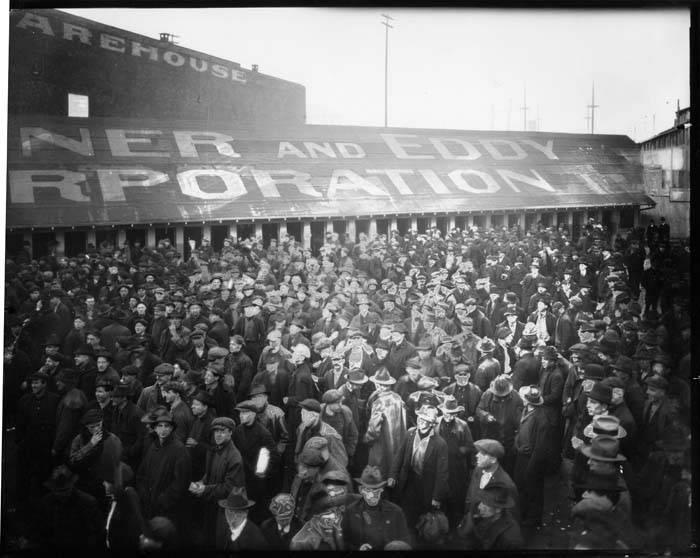
Suspicions of Bolshevik Interference
The American public was thoroughly convinced that the Bolsheviks were behind the so-called revolution. Adding fuel to the fire was a Russian ship that had found its way into the harbor in Seattle a few months prior. Many alleged that it was carrying money for IWW agitators to fund the rebellion.
In the aftermath, several IWW workers were arrested, tried, and convicted as Bolshevik agitators. However, it was too late, as the success of the Seattle general strike inspired countless other strikes throughout the year.
As the strike wave was hitting the country, anarchists were busy at work plotting more bombings. Due to fears of Bolsheviks, US officials had been busy prosecuting anarchist groups, including the Galleanists. In April 1919, the Galleanists commenced their first wave of bombing attacks that year.
Intended to explode on or around May Day, the bombers wanted to attack politicians, judges, and other government officials who had enacted, supported, or enforced Sedition, Immigration, and Espionage Act cases against anarchists and socialists.
Mailing the Bombs
In late April 1919, the bombers set off 36 bombs in the mail to high-profile individuals, including large capitalists like J.P. Morgan and Rockefeller. The postal service delivered only a handful of bombs, thanks to the anarchists not putting sufficient postage on most. However, they were not over yet.
In early June, the group mailed out a second series of eight much larger bombs. The intended targets included previous individuals from the first list, including US Attorney General Mitchell Palmer.
These bombs killed two people, including a bomber, and injured several others. The second wave of bomb attacks also severely damaged Palmer’s personal residence and almost killed future President Theodore Roosevelt, who had walked in front of his home just minutes before the bomb exploded.
Racial Violence
As a result of these bombings, the campaign of racial violence against African-Americans accelerated. Beginning in April of that year in Georgia, white mobs had started to attack and murder black residents at will.
They destroyed many of their homes and businesses. Unlike previous racial violence, the African-American population began to fight back.
Why white Americans began an indeterminate campaign of racial violence that year was mainly due to language in the Overman report. As well as from returning black veterans.
African-American soldiers had seen how Europeans, especially the French, treated black people with dignity and respect as well as seeing them as full, equal citizens. Having seen how other people lived, they brought these ideas back home with them and energized numerous movements calling for racial and labor equality.
The language contained in the Overman report chided African-Americans as Bolshevik agitators. Their calls for equal rights, equal pay, and equal treatment were considered communist ideals.
As a result, white mobs, already frantic from the strikes breaking out across the country, began to attack black people indiscriminately. Because black Americans defended themselves, there were numerous cases of large numbers of white Americans being killed in self-defense by black Americans.
These killings perpetuated the cycle of violence across the country. The bombings did nothing but exacerbate an already growing problem.
Throughout 1919, no fewer than 36 race riots broke out in the United States. They were all perpetrated and instigated by white Americans. Local and state governments did nothing to stop the violence.
The federal government continued to blame anarchists and Bolsheviks as the root cause of the violence. They doubled down on their efforts to create a mass wave of arrests to remove this element from the US once and for all.
These efforts became known as the Palmer Raids.
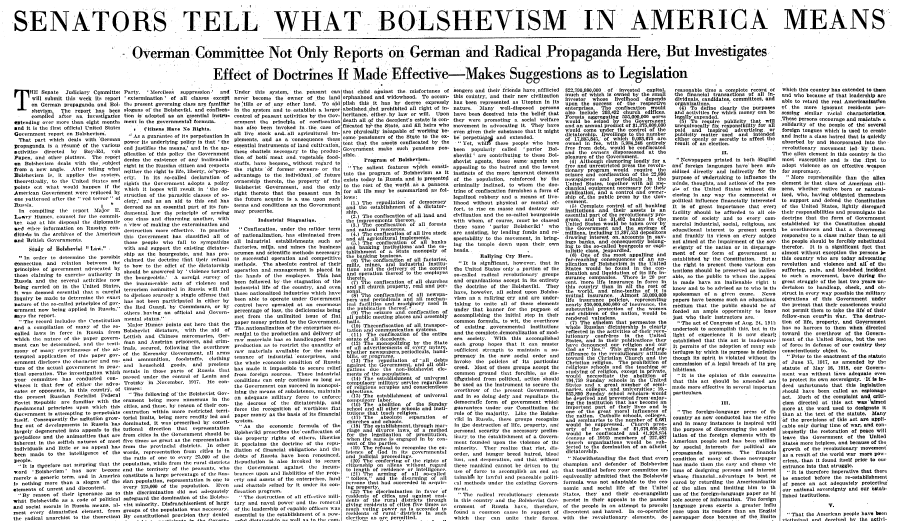
Palmer Raids
In the immediate aftermath of the June bombings, Attorney General Palmer was incensed.
He conducted several initial raids in New York State against supposed communist elements identified in the New York State Lusk Committee, a state equivalent to the Overman committee. He then became dismayed at the results.
Federal judges threw out most cases against most of those arrested during the July raids.
Not trying to be dismayed, he learned from these early raids that it was better and more expedient to have so-called anarchists, radicals, and communists deported rather than face prosecution in the US legal system.
To this end, he appointed J. Edgar Hoover. He would become the future leader of the FBI, to the General Intelligence Division of the FBI’s precursor, the Bureau of Investigation.
With Hoover at the helm, he and Palmer worked together to create a list of allegedly 60,000 alien agitators in the US. During his first round of arrests in November 1919, he timed it to coincide with the second anniversary of the Bolshevik revolution.
Several thousand arrests were made across 12 cities. But there was just one problem.
Immigration detention warrants had to be signed off by Department of Labor Officials. Deportations were also being ordered by them. Therefore, Hoover and Palmer had to find sympathetic officials to sign off on these warrants.
They had great difficulty doing so. Distracted by the great United Mine Workers strike in November and December of that year, he restarted his plans in earnest in the new year.
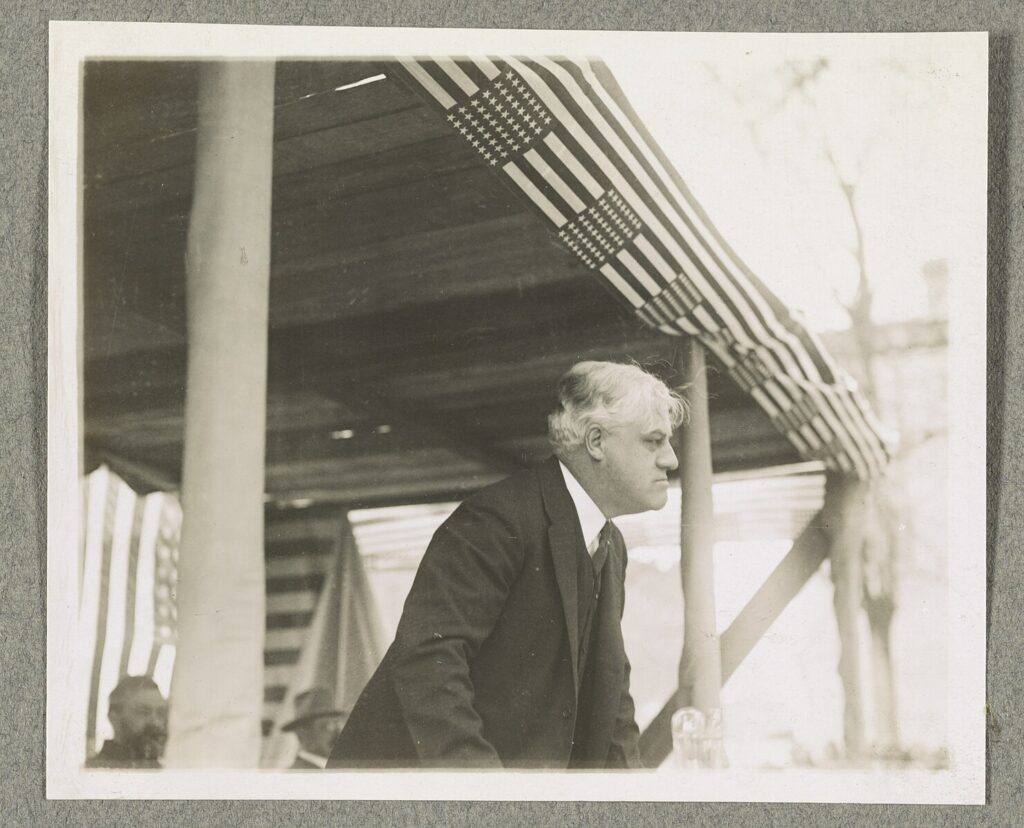
The Raids Continue
In January 1920, Palmer executed another series of raids larger than the first. Thousands were arrested during six weeks across the country.
However, many of those held in confinement were not aware of the charges against them. They were held without bail, did not have access to an attorney, and were held in miserable conditions.
Due to Palmer’s heavy-handedness, the American Civil Liberties Union was founded in direct response to the raids. They began fighting Palmer in court, along with lambasting him in the press.
As a result of their actions, many cases against those arrested were dropped. Just over 500 people were eventually deported.
Despite the overall failure of the Palmer Raids, he continued to advocate for further action. He claimed that the country would see another wave of attacks as a result of court system failures on May Day, 1920.
However, May 1 came and went without anything happening. Because of this, the media made a mockery of Palmer. As a result, many politicians and the American public at large began to question the heavy-handed methods of men like Palmer, and the Red Scare quickly died off in the summer of 1920.
Conclusion
Thanks to the efforts of organizations like the ACLU and NAACP, the American public and political leadership began to become aware of the excesses of the Red Scare. The poor results of the Palmer Raids show concrete proof there never really was an imminent communist takeover of the US.
However, despite the end of large-scale violence and arrests, it was not the end of communist witch hunts. Over the next two decades, the quest to root out communist sympathizers would continue at a low level until flaring up once more after World War Two.
With the age of McCarthyism, the groundwork had been laid in 1919. Many of the same institutions and tactics would be scaled up to prosecute so-called communists, socialists, anarchists, and un-American elements at an even more massive scale than before.
References
https://www.dncr.nc.gov/blog/2016/02/11/senator-lee-overman-and-red-scare-1919
https://archive.org/details/popularculturepo0000unse/page/68/mode/2up?view=theater
https://archive.org/details/conspiracyfearof0000curr/page/152/mode/2up?view=theater
https://archive.org/details/toamericanpeople00natiuoft/page/18/mode/2up?view=theater
https://web.archive.org/web/20150612082301/https://journals.psu.edu/phj/article/download/24198/23967
https://www.jstor.org/stable/2146574?read-now=1&seq=18#page_scan_tab_contents

